Throwback Thursday is when we trawl through the That's archives for a work of dazzling genius written at some point in our past. We then republish it. On a Thursday.
Ten years ago Yangshan was just a tiny collection of islands some 35 kilometers out into the East China Sea, and home to nothing more than a fishing village. Now, linked to the Chinese mainland by the third-longest ocean bridge in the world, its deep water port operates lines to more than 300 ports internationally, accounting for a third of the throughput of the Port of Shanghai, the busiest and largest cargo port in the world. And Yangshan Deep-Water Port is nowhere near being finished. Eventually it will become the biggest deepwater port ever built.
From 1684, when Qing Dynasty Emperor Kangxi (1654-1722) reversed the 1525 Ming Dynasty prohibition on ocean-going vessels, Shanghai began to become one of China’s most important ports, located as it is halfway down China’s Eastern seaboard at the point where the Yangtze, the world’s third longest river, empties into the East China Sea.

In 1732, Emperor Yongzheng moved the customs office for Jiangsu from Songjiang to Shanghai, giving Shanghai exclusive control over customs collections for the province’s foreign trade. Then, at the conclusion of the First Opium War in 1842, Shanghai became a treaty port, developing into a city of international commerce. By the early 20th century, Shanghai was the largest port in the Far East, as well as the largest city.
With the Communist takeover in 1949, overseas trade was cut dramatically, and the merchant-based economy of Shanghai started to slow down. However, with the policies of Reform and Opening-up kicking in in the 1980s, things began to grow at an unprecedented pace. Billions of dollars of goods started flowing down the Yangtze to be shipped abroad, and Shanghai’s container traffic began growing 30% year-on-year. In 2001, it was 300 million tons of cargo. By 2005, that number had grown to nearly 800 million.
Shanghai should have been perfectly positioned to take full advantage of the boom. But it had a problem. Along with all that cargo, every year millions of tons of silt is washed down the river and into the ocean, where it piles up in sand bars. At low tide, the entrance to the Yangtze is only 7 meters deep. And just as China had undergone a revolution, so had the world of international shipping.
After WW2, shipping containers had changed the face of the cargo industry. Unlike loose cargo, packed containers could be offloaded straight onto trucks and driven away. And the bigger the container ship, the more cost effective each journey. Gigantic container ships became the way to move freight across the planet. Vessels that could clear seven meters were becoming a rarity.
Shanghai’s clogged aquatic arteries were becoming life threatening; if the ships couldn’t get their cargos in and out of Shanghai, they would go elsewhere. China was becoming the world’s number one exporter – the CIA World Factbook estimates China’s exports to have risen to USD1,500,000,000,000 (one and a half trillion dollars) by 2010, 10% of the global total.
Failure to act would have proved seriously costly. In response, in the 1990s Shanghai built new container ports at Waigaoqiao, at the mouth of the Yangtze. Ships docking at Waigaoqiao didn’t need to sail up the Huangpu, and the water was 12 meters deep.
The solution proved short-lived. Container ships simply kept getting bigger, reaching post-Panamax proportions (so called because their dimensions mean they are too large to pass through the Panama Canal). In the 21st Century, over 30% of the world’s shipping containers began to be transported on post-Panamax vessels. Waigaoqiao was no longer deep enough, and Shanghai needed a new solution.
In 2002, the Shanghai government decided on a plan so ambitious it is hard to conceive any nation but China attempting it: expanding a few small islands in Hangzhou Bay into the world’s largest deep-water container port. A port with a depth of 15 meters, where 30 ships could dock at one time. A port that could process 15 million shipping containers in one year – over 40 thousand each day. And all for an estimated cost of RMB80 billion. The statement was clear: Shanghai had no intention of relinquishing its status as a global shipping center.
To achieve their vision, engineers had to build an artificial island, increasing Yangshan’s area by 60%. With the sea floor 15 meters deep, that took millions of cubic meters of rubble and soil, much of which was dredged from the ocean floor by a gigantic vessel called the Sea Dragon. The beast can suck up 12,888 cubic meters of silt in an hour. Working for the best part of a year, it dumped nearly 3,000 million cubic meters of mud to complete phase one of the port.
That began operations in December 2005, with the opening of the Donghai Bridge, a six-lane highway that took 6,000 workers two and half years to construct, and snakes 32.5 kilometers from Yangshan to the mainland. It was this that we crossed one night last month when we were invited by Jamie Wrightson, Commercial Manager of Wallem Shipping (China) Ltd., to watch one of his ships, the CCNI Conception, unload.
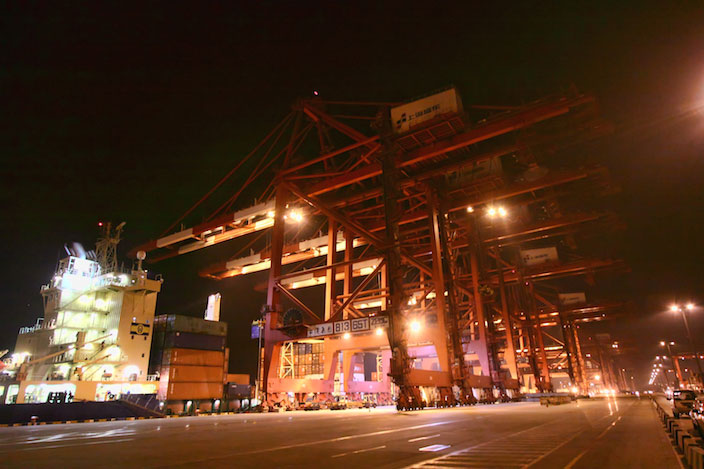
Image by Andy Campbell for That’s
The first thing that struck us on arrival (after the strange sensation of driving on a road over water for a full half an hour) was how busy the port was at night. Phase three of the port has been completed and Yangshan now has 17 berths, all floodlit to service the constant 24-hour stream of cargo-laden ships that dock. Around us, truck engines roar and containers clatter down at a pace that is terrifying considering the scale of the equipment.
Let’s starts with the ship-to-shore cranes that offload the containers from the ships; 50 meters high, the quay is so long that standing at one end you cannot see to the other. There must be something like 40 of them, all on a giant set of rails so they can slide from berth to berth. They were built right here in Shanghai by the Zhenhua Port Machinery Company (ZPMC). Located on Changxing Island at the mouth of the Yangtze, it is the biggest crane factory in the world.
Called STS-40, they were a new design built especially for Yangshan; most cranes can lift one 40-foot container or two 20-foot containers at a time. The STS-40 can lift double that, and are tall enough to do it off the biggest ships in the world. So while most container port cranes can handle about 30 containers an hour, Yangshan’s cranes can handle over 50.
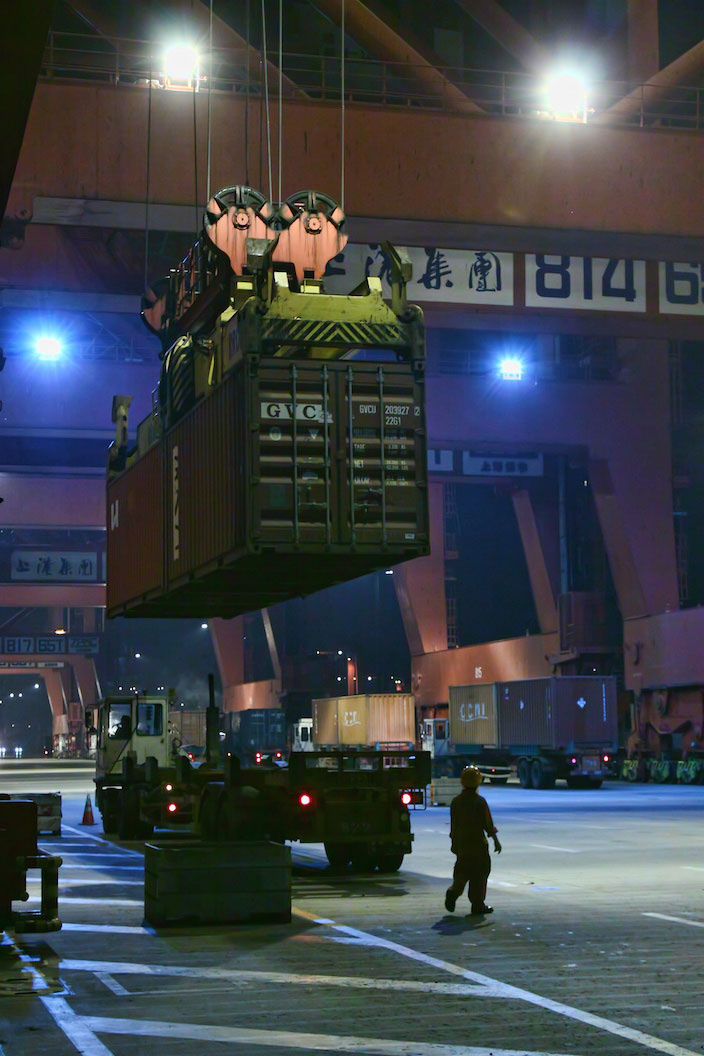
Image by Andy Campbell for That’s
This is in no small part due to the skill of the crane drivers, who are strapped in cabs overhanging the ships, lowering a lifter (called a spreader, or a Bromma after its manufacturer) onto the containers like a colossal incarnation of the fluffy toy fairground claw machine.
Only these toys weigh two and a half tons, and that’s when they’re empty. Moving into position over the container with a joystick, once it is in place the driver triggers automatic locks with the push of a button on his joystick, and swings it over the deck in a pendulous motion onto an awaiting truck, known as a port tug.
This maneuver is even more difficult the other way round, we are informed, as the operator must lower each container onto the pins of the container it is to rest on on the ship. It is like fitting giant pieces of Lego atop each other – only slightly more unwieldy – dangling from 50-meter-long cables. And all this must be done with the utmost delicacy; a bumped container might mean damaged goods – a wayward swing, a dead colleague.
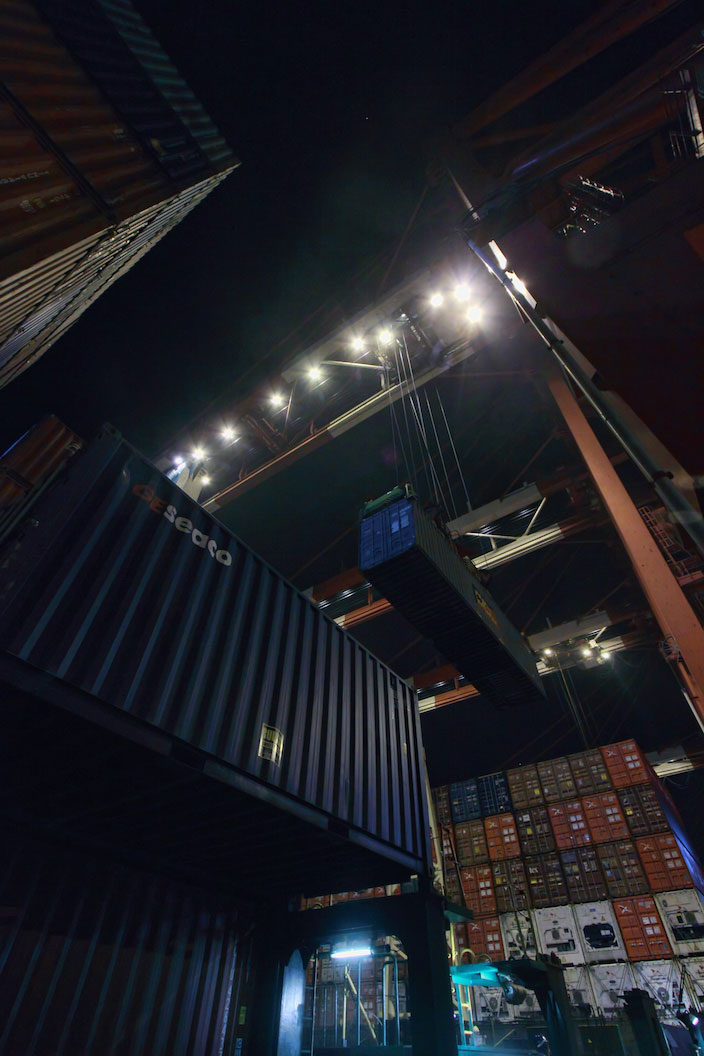
Image by Andy Campbell for That’s
The containers removed from the ship are sped away from the dock to the container yard by the port tugs, where another type of crane, known as a rubber-tired gantry crane, collects them up and places them in stacks. The gantry cranes’ movements along and across the paths are like that of long-legged rust-red-colored crabs, while the rows upon rows of containers are reminiscent of that final warehouse scene in Raiders of the Lost Ark.
That is partly because there are so many of them, and partly because the containers are effectively indistinguishable from one another. So how do they not all get lost and forgotten (as the Ark presumably was)? This is where Yangshan’s cutting edge computer control system comes in.
Before each ship sails, the shipping company will analyze the content and destination of each of its containers, and assign it a position on the ship, which is then relayed to Yangshan. The ship-to-shore cranes, port tugs and rubber-tired gantry cranes all have cab displays electronically linked to the central control, so crane operators and drivers know exactly which containers to move, when to move them and where to move them to.
Meanwhile, a CCTV supervising system, walkie-talkie contact and laptops with detailed up-to-the-minute operation plans on the wharf all act as backup insurance. While the scope for something going wrong is exponential, Yangshan runs with an error rate of less than 1%.
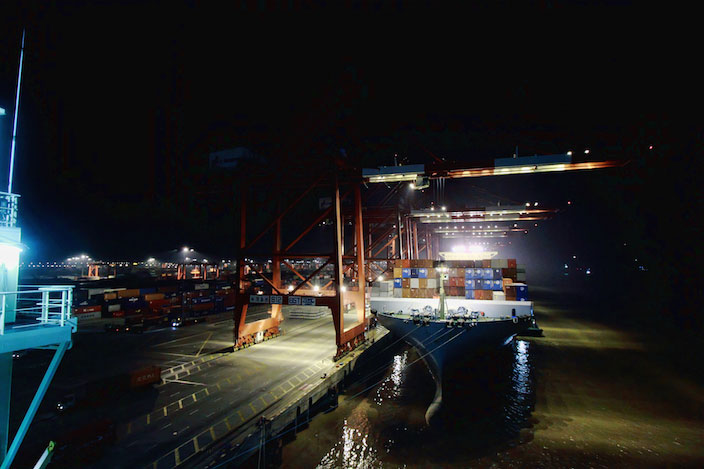
Image by Andy Campbell for That’s
The constant cacophony of this computer choreographed dance of containers, cranes and port tugs is a wonder to behold, made all the more impressive that out of this seemingly chaotic scene is created an against-all-odds order.
The statistics speak for themselves. Since starting operations in late 2005, Yangshan Deep-Water Port’s annual growth rate of container throughput volume has been 32.5%. By mid-2007, Yangshan had helped the Port of Shanghai surpass Hong Kong to become the second busiest container port in the world, just one million containers behind Singapore. In 2010 it passed Singapore, becoming the world’s busiest and largest container port, with a total container throughput of 29 million TEUs.
More than RMB10 billion will be spent in building new deep-water berths in the port, Wang Xuan, general manager of Yangshan Tongsheng Port Construction Co Ltd., recently announced. Throughput at Yangshan is projected to be 12.3 million TEUs in 2011, up 21.78% from 2010.
The visionary gamble taken by Shanghai some 10 years ago has paid off. Who’s to doubt the dream of Yangshan being the biggest deep-water port in the world by 2020?
This article first appeared in the August 2011 issue of That's Shanghai. To see more Throwback Thursday posts, click here.
[Cover image via Storify]
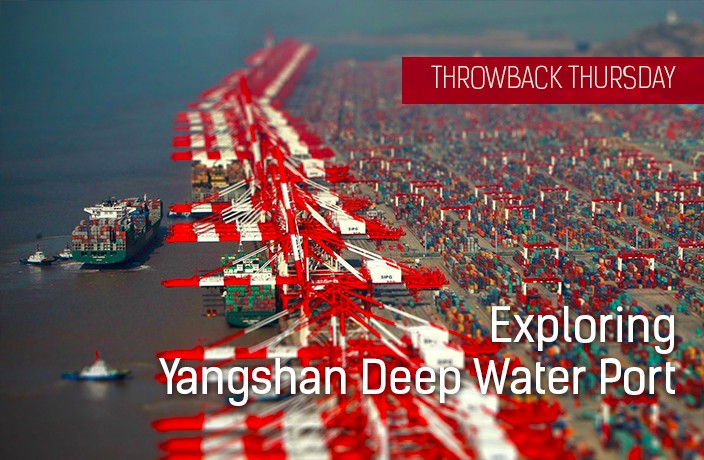




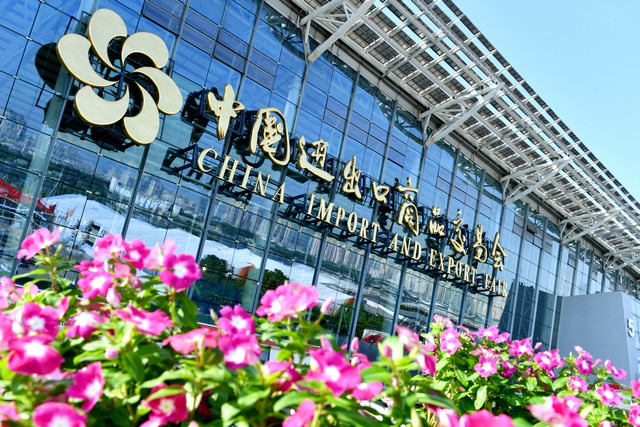
















0 User Comments